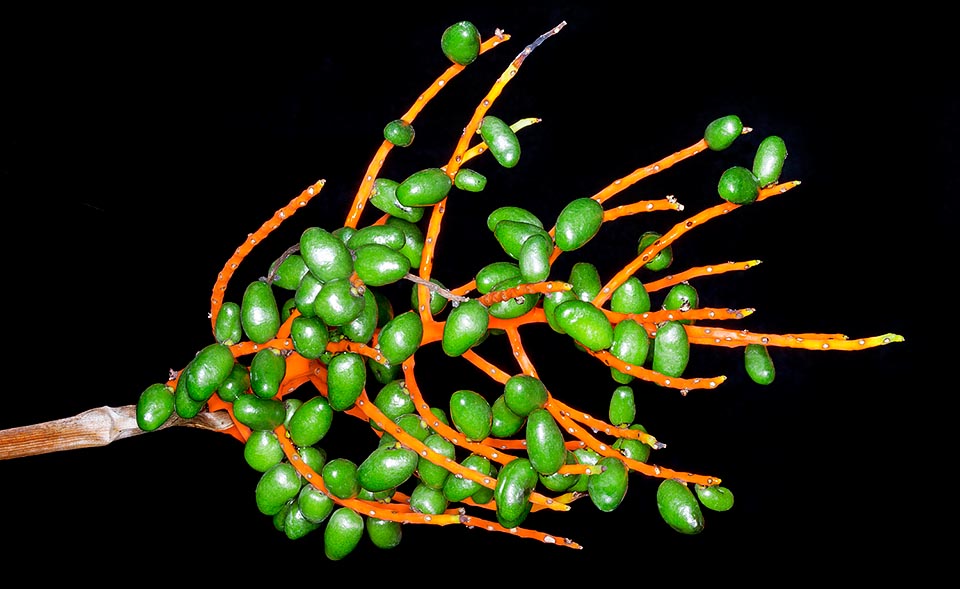Family : Arecaceae

Text © Pietro Puccio

English translation by Mario Beltramini
The species is native to Belize, Guatemala, Honduras, Mexico (Campeche, Ciapas, Oaxaca, Puebla, Quintana Roo, Tabasco and Vera Cruz), where it grows in the humid forests at low altitudes, mainly on calcareous soils.
The name of the genus is the combination of the Greek adverb “χαμαί” (chamai) = on the ground, on the soil, and of the substantive “δωρέα” (doréa) = gift, the German botanist Carl Ludwig Willdenow (1765-1812), who created the genus in 1806, did not specify the exact meaning of the name. The name of the species comes from the Latin name “oblungus, a, um” = oblong, with reference to the shape of the fruits.
Common names: caugui palm (English); caquib, xaté macho (Guatemala); brillosa, coyolito, jilote de monte, palmilla, palmita, tepejilote (Mexico); pacayta (Nicaragua).

Chamaedorea oblongata is an American species, quite variable, that does not surpass the 3 m of height © Giuseppe Mazza
Inflorescences, on a 10-35 cm long peduncle, under the leaves (infrafoliar), ramified, the male ones with green rachis and rachillae and flowers, of about 4 mm of diameter, of green colour spirally arranged, the female ones with initially green rachis and rachillae, then orange red when in fruit, with female flowers, of about 2 mm of diameter, spirally arranged.
Fruits of variable shape, globose to oblong, to lunate, of initially green colour, then glossy black when ripe, 8-14 mm long and of about 7 mm of diameter, containing only one ellipsoid seed about 7-10 mm long and of 5 mm of diameter.
It reproduces by seed in draining loam maintained humid at the temperature of 24-26 °C, with germination times starting from about 3 months.
Species standing among the first of the genus to be introduced in cultivation for ornamental purposes, as garden plant, in the tropical, subtropical countries and marginally in the temperate-warm ones, where it can resist to temperatures up to about -2 °C for short period, as well as for the decoration of inner spaces, even if little luminous, in pot. Of easy cultivation, it prefers a semi-shaded exposition, far from the direct rays of the sun, and is not particular about the soil, provided draining. Regular waterings in summer, thus to maintain a constant humidity, but without stagnations, spaced in winter, but without ever allowing the substratum to dry up completely. Monthly fertilizations, from spring to autumn, with hydrosoluble products, with microelements, at half the dosage shown on the package. The cut leaves are utilized in the floral compositions.
Owing to the reduction of its habitat and the indiscriminate harvesting, linked to the local and international trade, the species has been inserted in the red list of the I.U.C.N. (International Union for the Conservation of Nature) as “vulnerable” (at risk of extinction in nature).

Much cultivated but vulnerable in nature due to the reduction of its habitat and the indiscriminate harvest, has emerald fruits of rare beauty that turn black when ripe © Giuseppe Mazza
→ For general notions about ARECACEAE please click here.
